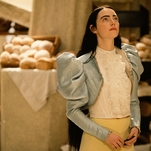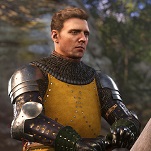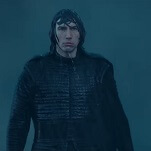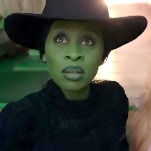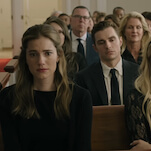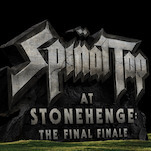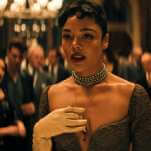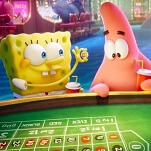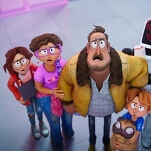Each week, Big Issues focuses on a newly released comic-book issue of significance. This week, it’s Locke & Key: Grindhouse. Written by Joe Hill (Horns, 20th Century Ghosts) and drawn by Gabriel Rodriguez (Beowulf, Clive Barker’s The Great and Secret Show), it’s a remarkable example of how to create a satisfying one-off short story.
In 2008, Joe Hill and Gabriel Rodriguez opened the doors to Keyhouse, a mansion full of deadly secrets and magic keys with a history that has slowly been revealed over the course of Locke & Key. As the acclaimed horror series prepares for its final act (the six-issue miniseries Ω), Hill and Rodriguez provide a glimpse into Keyhouse’s past with Locke & Key: Grindhouse, a one-shot featuring a Depression-era short story along with maps showing the extensive details of Rodriguez’s Keyhouse design. Like last year’s Guide To The Known Keys, the story in Grindhouse is remarkably substantial considering its length. But whereas Guide’s “Open The Moon” went for emotional gravitas, Grindhouse is Locke & Key is at its most fun, showcasing Hill and Rodriguez’s ability to balance horror and humor as the Locke family protects its home from a trio of Canadian gangsters.
Joe Hill’s pacing is one of his greatest strengths, and he opens this issue with a bang, or more literally a “BLAMMM” as a bald thug by the name of Michael shoots a police officer in the chest, then in the head. He’s robbing the Sandpiper House Resort with Phillipe, who used to work in the Keyhouse garden, and Louis, Phillipe’s psychotic brother who is as excited to score a bra from the burglary as he is a duffel bag full of cash. The trio flees to Keyhouse to wait for their getaway boat and force themselves in the house when Mary Locke opens the door, unaware that this will be the end of their journey. Hill keeps the tension building as the men intimidate Mary’s husband and her sister Jean, then pretend to be old friends of the family when Mary’s two sons come in to eat some pie. Phillipe and Louis have the women take them on a tour of the house as Michael watches over the boys and their father, but splitting up is the worst thing a group could do in a haunted house.
Hill keeps readers waiting for the appearance of the book’s signature magic keys, establishing the grave reality of the home invasion before turning the tables on the thieves via supernatural means. As fantastic as Locke & Key gets, it always feels like it could take place in reality, which is why its so exciting when someone turns a key and something magical happens. The anticipation is part of the fun, and the more despicable Hill makes Grindhouse’s trio of villains, the more satisfying it is when they meet their demise. Louis is the most demented of the bunch, with a perpetual grin across his face as he fantasizes about hairy Toronto pussy and talks about how he would keep his bra and heels on during sex if he were a woman. His dialogue is comically exaggerated, but it foreshadows his ultimate fate: undergoing a sex change when Jean uses the gender key. Each of the thieves meets an end that is fitting punishment for their crimes, and the chauvinistic Louis is turned into the exact type of woman he lusts over.
Mary takes Phillipe to her bedroom and explains that she is the only person who knows the true value of the objects that he might be likely to steal, but when it comes to Keyhouse, one should really be careful about touching anything. Mary is warning him, giving him one last chance before she shows him exactly how deceptive appearance can be in her home. She leads Phillipe to believe that she’s opening a door to hidden valuables when she inserts a key with a gaping red mouth on the end, but it’s all part of her plan. He knocks her out of the way and opens the door himself, the equivalent of putting a gun to his head and pulling the trigger. When he walks through the doorway, he steps into a giant mouth; Philippe led the thieves to Keyhouse, and the house literally devours him in return.
Michael is the only thief who actually kills anyone in this story, and he meets an end worse than death as he steps through the ghost door and dooms himself to live as a spirit without a body. As his dead body lies on the floor, the family dog licks berry pie filling off the man’s face, ending the carnage with an image that is both eerie and adorable. The story ends with Louis (Louise?) running out of Keyhouse with her arms covering her newly-formed breasts, with the Locke family standing at the door fully confident that they’re the masters of their domain. The front gate closes on its own once Louis sprints off the estate, the jaws of Keyhouse closing with a “clac!” after a filling meal.
Gabriel Rodriguez’s art has an animation influence that initially seemed an odd fit for Hill’s dark story, but his impressive design and storytelling skills have proven him to be an ideal collaborator. His environments and characters are impeccably detailed, and his understanding of facial expressions and body language helps land all the emotional beats of Hill’s story. Compare the full body shots of Jean and Mary on pages 7 and 8: they are both facing forward with their arms crossed, but while Jean is clutching herself in fear, Mary is guarded but confident, with her hip cocked and shoulders lowered. As could be gleaned from the cover, red is the dominating color in Grindhouse, and an ominous crimson night sky looms over all the action. Jay Fotos utilizes a muted color palette to give the art an old newsprint look, and Robbie Robbins’ blocky lettering helps the illusion.
Grindhouse includes “The Guide To Keyhouse,” a collection of maps and elevations that show the incredible amount of work Hill and Rodriguez have put into creating their environment. In his introduction to the guide, Hill describes his collaboration with his artist: “He does 80% of the work, and I look good 100% of the time.” Looking at the extensive blueprints on the following pages, that labor is clearly evident, with over 40 rooms spanning the five floors of Keyhouse. The maps also feature annotations from Hill, including teasers for potential Locke & Key stories after the main story ends. It’s nice to know that the creators are open to returning to the mansion in the future, because these one-shots have shown that there are still plenty of riveting Keyhouse stories to be told.







